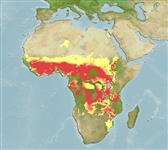Actinopterygii (ray-finned fishes) >
Siluriformes (Catfish) >
Clariidae (Airbreathing catfishes)
Etymology: Heterobranchus: Greek, heteros = other + Greek, brangchia = gill (Ref. 45335). More on author: Valenciennes.
Environment / Climate / Range
Ecology
Freshwater; demersal; potamodromous (Ref. 51243); depth range 10 - ? m (Ref. 7248). Tropical; 22°C - 23°C (Ref. 2059), preferred ?; 25°N - 22°S, 16°W - 40°E
Africa: Nile, Congo system, upper and middle Zambezi (Ref. 3820). Reported from Lake Rukwa and the lower Zambezi (Ref. 95585). Also from Lakes Tanganyika and Edward (Ref. 7248). In West Africa known from the Gambia, Upper Senegal, Niger, Benue, Lake Chad, Volta, and coastal basins from Guinea to Nigeria, including the delta of Niger and the Cross river (Ref. 57129).
Size / Weight / Age
Maturity: Lm ? range ? - ? cm
Max length : 150 cm SL male/unsexed; (Ref. 4967); max. published weight: 55.0 kg (Ref. 7248)
Dorsal
spines
(total): 0;
Dorsal
soft rays
(total): 26-35;
Anal
soft rays: 42 - 52;
Vertebrae: 55 - 61. Diagnosis: length of rayed dorsal fin 27-36% standard length; 26-35 dorsal-fin rays; length of adipose fin 24-34% standard length; strong, downward-pointed serrations on the anterior part of the pectoral spine; width of vomerine tooth plate 25.0-32.2%, and width of premaxillary tooth plate 29.5-36.9% head length (ref. 57129). Posterior part of adipose fin blackish (Ref. 4967, 57129). Caudal fin with a whitish cross-bar (Ref. 57129). Head long, broad and somewhat rectangular in dorsal outline; snout broadly rounded; eyes superolateral in position; frontal fontanelle long and narrow; occipital fontanelle oval-shaped; tooth plates wide; suprabranchial organ well developed; pectoral spine strongly serrated on anterior side; caudal fin barred; openings of secondary canals hardly visible but display a regular pattern (Ref. 270).
Coloration: preserved specimens: grey, greyish-brown to dark brown on back and sides, and pale brown to whitish on belly; some individuals marbled, particularly on posterior part of body; caudal fin often crossed by several vertical bars, one of which is whitish, hind margin of fin often white-edged; posterior part of adipose fin darker than anterior part (Ref. 57129).
An uncommon species which inhabits large rivers (Ref. 4967). Largest freshwater species in southern Africa; occurs in large deep rivers within the mainstream or in deep pools and lakes or backwaters (Ref. 7248, 78218). Most active at night, feeding on any available food, including invertebrates and insects when small, fish and other small vertebrates when large; scavenges off large carcasses and offal from riverside villages; live for 12 or more years (Ref. 7248). Maximum reported size for West Africa: 610 mm TL (Ref. 57129).
Life cycle and mating behavior
Maturity | Reproduction | Spawning | Eggs | Fecundity | Larvae
Teugels, G.G., B. Denayer and M. Legendre, 1990. A systematic revision of the African catfish genus Heterobranchus Geoffroy-Saint-Hilaire, 1809 (Pisces: Clariidae). Zool. J. Linn. Soc. 98:237-257. (Ref. 270)
IUCN Red List Status (Ref. 115185)
CITES (Ref. 94142)
Not Evaluated
Threat to humans
Harmless
Human uses
Fisheries: minor commercial; aquaculture: commercial; gamefish: yes
Tools
Special reports
Download XML
Internet sources
